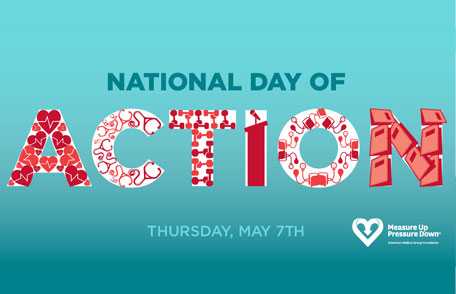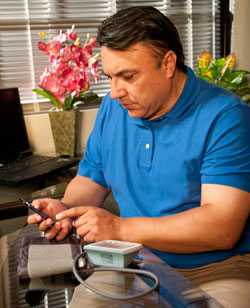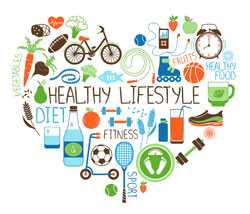National Day of Action
 "Roll Up Your Sleeves" for National High Blood Pressure Education Month
"Roll Up Your Sleeves" for National High Blood Pressure Education Month
Uncontrolled high blood pressure [380 KB] is a leading cause of heart disease and stroke. Today, about 70 million adults in the United States are living with high blood pressure.1 This year, to recognize National Blood Pressure Education Month, the Centers for Disease Control and Prevention (CDC) and Million Hearts®—a national initiative to prevent 1 million heart attacks and strokes in the United States by 2017—is teaming up with the American Medical Group Foundation (AMGF) and its Measure Up/Pressure Down®2 campaign's National Day of Action: Roll Up Your Sleeves!3 event on May 7.
By encouraging everyone to take at least one heart healthy action today, May 7, we can raise awareness of and potentially reduce high blood pressure across the country. These actions can take different forms, such as getting your blood pressure checked for the first time this year, asking someone you love to get their blood pressure checked, or even going for a long walk. By coming together and taking action, we hope to help Americans get (and keep) their blood pressure under control, and reduce their risk for heart attack and stroke.

There are many ways to check your blood pressure, including at your health care provider's office, at a local pharmacy, or even at home.

Certain lifestyle changes can help control blood pressure.
Roll Up Your Sleeves Today
High blood pressure, sometimes referred to as the "silent killer," often has no signs or symptoms, which is why it is important to have your blood pressure checked regularly. Today, there are many ways to check your blood pressure, including at your health care provider's office, at a local pharmacy, or even at home.
Many free resources are available to help manage and track blood pressure. The American Heart Association/American Stroke Association and Million Hearts® offers an online tool called Heart360®4 AMGF offers helpful information5 about how to best track blood pressure. If you know you have (or a loved one has) high blood pressure, resources such as Circulation Nation: Your Roadmap to Managing High Blood Pressure [13.4 MB]6 and High Blood Pressure: How to Make Control Your Goal [706 KB] could be helpful for ongoing management and control.
Six Ways to Make Blood Pressure Control Your Goal
While not always easy, certain lifestyle changes can also help control blood pressure. The Measure Up/Pressure Down® campaign has identified the following steps to help control your blood pressure. Consider one or more of them today (and beyond) to make control your goal: [1.1 MB]
- Know your numbers. Understanding what blood pressure is and what your numbers are is an important first step. Work with your health care team to determine your individual blood pressure goals and treatment plan if your numbers are too high. Keep track of your numbers by using the free Million Hearts® wallet card. [920 KB]
- Eat right. A diet with excessive sodium can lead to high blood pressure. Increase the fruits and vegetables you eat and limit consumption of high fat and sodium foods. One way to control what you eat is to make your own meals. Visit the Million Hearts® Healthy Eating and Lifestyle Resource Center for lower-sodium recipes, heart-healthy recipes, meal plans, and articles.
- Stay active. On average, people who are more active tend to have lower heart rates, which can improve and prevent high blood pressure. Adults should be active at least 150 minutes a week.
- Reduce stress. Many Americans respond to stressful situations by eating more, getting less exercise, drinking, or smoking. Plus, a stressful situation can also increase blood pressure for a short period of time. Try to reduce the occurrence of these situations and look for healthy ways—like meditation or walking—to help you deal with stress.
- Take medication. Follow your health care professional's orders and stick with your medication plan. Discuss any side effects with your doctor to explore other treatment options. Remember to take your medication by getting organized; use a smartphone medication reminder app or use a daily pillbox, if needed.
Join CDC today and throughout May in Rolling Up Your Sleeves! and controlling high blood pressure. For more information, visit CDC's High Blood Pressure website or the Measure Up Pressure Down website.
References
- Centers for Disease Control and Prevention. Vital signs: awareness and treatment of uncontrolled hypertension among adults—United States, 2003–2010. MMWR. 2012;61(35):703-9.
- American Medical Group Foundation. Measure Up/Pressure Down® website.
- American Medical Group Foundation. Measure Up/Pressure Down®. National day of action: roll up your sleeves! website.
- American Heart Association/American Stroke Association. Million Hearts® and Heart 360® websites. List URL, Add accessed date
- American Medical Group Foundation. Measure Up/Pressure Down®, Track Your Numbers website. List URL, Add accessed date.
- American Medical Group Foundation, Measure Up/Pressure Down®. Circulation Nation: Your Roadmap to Managing High Blood Pressure website. List URL, Add accessed date.
- Page last reviewed: May 6, 2015
- Page last updated: May 6, 2015
- Content source:
- National Center for Chronic Disease Prevention and Health Promotion, Division for Heart Disease and Stroke Prevention
- Page maintained by: Office of the Associate Director for Communication, Digital Media Branch, Division of Public Affairs




 ShareCompartir
ShareCompartir